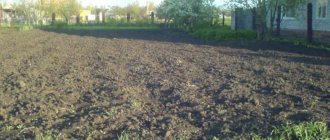1
Joint ownership of an indivisible thing is problematic in terms of the operation of the item and the complexity of its sale. The same problems arise for land owners. Joint ownership of land may arise during marriage or in the event of inheritance. As a result, each owner cannot independently dispose of the plot or use it for its intended purpose. In such a situation, the law proposes to allocate its part. Let's consider how to register a share of a land plot as property.
What to do if the house is in shared ownership, but the land is not
Art. 35 of the Land Code of the Russian Federation provides for the need for a land plot and a residential building to be owned by one owner. In this regard, a citizen who has built a private house has the right to register ownership of the land plot.
The registration procedure depends on the owner of the land plot:
- if the owner is the state or municipality, then a citizen can register ownership of the land without obtaining the owner’s consent;
- if the owner is a private person, then the citizen has the right of first refusal.
The only condition is the presence of a residential building on the land plot, erected in accordance with the permission of the authorized body and put into operation properly.
Depending on the size of the land, the division can be made as follows:
- the plot is divided into 2 plots (if the total area allows);
- owners receive shares in the property.
Deadlines
If it is intended to allocate a share on a voluntary basis, it is necessary to gather all owners to obtain consent. If it is impossible to collect, the shareholders will have to be notified by letter of notification. The waiting period for a response is 1 month.
Land surveying work can take from 2 to 6 weeks depending on the availability of land and technical difficulties in allocating a share.
If the issue is resolved in court, the review process will take up to 2 months.
Why register a share of land as your property?
The law provides for the possibility of owning land plots:
- on the right of individual ownership;
- on the right of common joint ownership;
- on the right of shared ownership.
If in the first case there is only one owner, then in the remaining options there are several owners. Each of them is given equal rights in relation to the allotment. However, the possibility of use and disposal is limited by the presence of other owners. For ease of use, it is advisable to allocate the shares of each owner.
After registering a land plot as a shared ownership, the owner is vested with rights and obligations in relation to his share. He can sell it, bequeath it, donate it. At the same time, he is obliged to take care of it, use it for its intended purpose and pay taxes.
The law provides the following options for determining shares in a land plot:
- by agreement of the parties (on a voluntary basis);
- in court (if the parties cannot reach an agreement).
Price
The main cost item is land surveying work. On average, the price of work related to geodetic determination of the boundaries of shares no larger than 0.4 hectares will be about 30 thousand rubles. The work involves measuring the land plot, preparing a layout diagram for the cadastral plan and drawing up a boundary plan.
Work to restore the borders will cost an average of 2-3 thousand rubles. per point.
A separate cost item is state duty.
When filing a claim, you will have to pay a state fee. Its value is calculated in accordance with clause 333.19 of the Tax Code of the Russian Federation and ranges from 400 rubles. up to 60 thousand rubles. depending on the cost of the claim. The latter is defined as a part of the total cost of the site, commensurate with the owner’s share in the property.
Additional costs will arise in connection with state registration of real estate. The state fee for registering land will be 350 rubles. (clause 1.24 of article 333.33 of the Tax Code of the Russian Federation).
Prohibition on allocation of shares
The allocation of shares means the appearance of 2 new objects instead of one. Not every plot of land can be subdivided.
The law establishes a ban on allocation in relation to the following areas:
- a disputed object is located on the territory;
- the total area does not allow for division (the resulting areas are smaller than the minimum size);
- when allocating, the interests of co-shareholders are not respected;
- the plot is not subject to division by force of law.
If it is impossible to carry out an actual division, then the owner has the right to receive monetary compensation for the share. Compensation may be paid by agreement of the parties.
If the allocation of a share in kind is impossible, and the share is insignificant, then the court may force the payment of compensation. From the moment of receiving the payment, the citizen loses his rights to a share of the land plot (Article 252 of the Civil Code of the Russian Federation).
What documents confirm the right to part of the joint property?
The right to dispose of property must be documented. New property must be registered in the unified real estate register, and the owner, at the end of the procedure, is issued an extract from the Unified State Register of Real Estate (Clause 1, Article 28 No. 218-FZ).
It is she who confirms the right to own real estate from 2021. This is the so-called legal document. For a plot acquired before 1998, the document confirming ownership is a Certificate issued by the “land committee” of the municipality or an extract from the household register; from 1998 to July 15, 2021 – certificate of state registration of rights; after this date - an extract from the Unified State Register.
There are also title documents. They explain on what basis this or that object was transferred to the owner. Legal acts for land plots include (Article 8 of the Civil Code of the Russian Federation):
- agreements on the alienation of property and acceptance acts thereto;
- any court decisions;
- certificates of inheritance;
- documentary transactions (donation, barter, purchase and sale, rent).
As for common ownership of land plots, the situation depends on the type of ownership: shared or joint.
Joint ownership can arise in a number of limited cases:
- during the formation of peasant farms (Article 257 of the Civil Code of the Russian Federation);
- among SNT participants;
- for spouses who have not concluded a marriage contract (Article 256 of the Civil Code of the Russian Federation).
The reasons for obtaining such plots can also be completely different, primarily:
- any documentary transactions concluded during marriage;
- certificates of inheritance, etc.
For common shared ownership, the title documents may be:
- transactions (donation, barter, purchase and sale, rent);
- transfer of ownership of a share in property rights by inheritance (inheritance by law or by will);
- privatization of housing, i.e. free transfer to citizens of residential premises owned by the state;
- recognition of ownership of a certain share by a court decision.
Note! Title and title documents are inextricably linked. It is possible to register property only on the basis of acts confirming the emergence of property rights.
If for some reason the data on registration of ownership is not in the state register, it will be possible to obtain a document for the plot only on the basis of title documents.
Registration by agreement
Co-owners have the right to resolve the issue of division voluntarily. The law provides for mandatory notarization of transactions for the allocation of shares in a land plot.
The parties draw up the document in simple written form and have it certified by a notary. Based on the agreement, the parties register the ownership of shares or new land plots formed in place of the old one.
The procedure differs depending on the area of the object:
- If the size of the original plot significantly exceeds the minimum, then the parties draw up an allotment (each co-owner becomes the owner of a separate plot).
- If the size of the original plot does not allow for allocation, then the owners become shared owners.
To clarify the possibility of allocation, it is necessary to invite a cadastral engineer. A specialist will determine the boundaries of the site and give an opinion on the possibility of dividing the plot.
After receiving the decision of the cadastral engineer, you can register the property.
Important! Each owner has the right to a share in the land plot equal to the share in the residential building.
Algorithm of actions
Procedure for allocating shares on a voluntary basis:
- Determination of boundaries and registration of a cadastral passport.
- Collection of documents.
- Drawing up an agreement.
- Notarization.
- State registration.
If the share is registered in an agricultural plot or SNT, then it is necessary to hold a meeting of co-owners. When holding a meeting, minutes must be drawn up. However, if a share is allocated in a plot that has 2 owners, then a collection is not required.
The minutes of the meeting confirm the following points:
- notification of all co-owners about the division (allocation);
- owners' agreement with the boundaries of the plots;
- consent of the party to the division or allotment of plots.
Defining boundaries
A prerequisite for dividing or allocating plots is to carry out land surveying. The procedure involves determining the total area of the site and establishing boundaries.
Land surveying procedure:
- site visit by a specialist;
- taking measurements;
- registration of land surveying.
The document is submitted to Rosreestr for issuing a cadastral passport for the property. Information about boundaries, land surveying and cadastral registration is entered into the Unified State Register of Real Estate.
Important! In case of allocation of a site in kind, 2 boundary documents are drawn up. When allocating shares, one general survey will be required.
Collection of documents
To formalize the agreement, the parties must prepare the following documents:
- civil passports of adult owners and owners over the age of 14 years;
- birth certificates of minor owners;
- documents of representatives of minor owners;
- permission from the district guardianship department to carry out allocation of property of minors;
- notarized consent of the spouses of the parties (if the object was acquired during the marriage;
- title documents for the site;
- title documents for a residential building;
- technical documentation;
- cadastral passport;
- extract from the Unified State Register of Land and House.
Sample agreement on division of land
Sample agreement on division of land
Sample agreement on the allocation of a share in kind
Sample agreement on the allocation of a share in a residential building and land plot in kind
Notarization and state registration
Expert opinion
Stanislav Evseev
Lawyer. Experience 12 years. Specialization: civil, family, inheritance law.
The law provides for mandatory notarization of an agreement on the allocation of shares in a land plot. In this regard, it is advisable to entrust the execution of the agreement to a notary.
However, the parties must provide the specialist with a draft document and the necessary documentation.
Since 2021, the obligation to transfer documents certified by a notary for state registration to Rosreestr has been assigned to the notary. Therefore, citizens will not have to take additional actions.
Expenses
The procedure for drawing up an agreement on a voluntary basis requires the following costs
| No. | expenditures | Price |
| 1 | Surveying | 5,000 rub. per plot |
| 2 | Preparation of a cadastral passport | 10,000 rub. per plot |
| 3 | Drawing up a draft agreement | 2,000 rub. – 3,000 rub. |
| 4 | Notarization | 0.5% of the cadastral value of the property |
| 5 | Notarial services | From 5,000 rub. (depending on region) |
| 6 | State registration | 350 rub. |
If the object is registered as common shared ownership, then the costs are divided between the owners in accordance with the size of the shares. When allocating a share in kind, each owner bears the listed expenses independently.
Registration deadlines
It is difficult to determine how much time will be spent on registration. It all depends on what stages need to be completed. Registration of a land plot requires the greatest amount of time.
Period for land registration under the agreement:
- land surveying – up to 6 months (depending on the region);
- cadastral registration – up to 30 days;
- preparation of an agreement – 1-2 days;
- collection of documents – 14 days;
- notarization – 1 day;
- state registration – 7 – 14 days.
State registration of real estate
To register the formed plot as property, you must contact Rosreestr with the following documents:
- passport;
- application (a sample is issued at the place of application);
- an agreement signed by all shareholders, or a corresponding court decision;
- title documents;
- cadastral passport.
If the new site has not yet been assigned an address, a document is submitted indicating information about the previous site.
Registration is completed within 10 days (through the MFC - 12 days). As a result, the owner is issued an extract from the Unified State Register of Real Estate, containing information about the registration of the property in the cadastral register and registration of ownership rights.
Registration in court
If it is not possible to reach a general agreement, then the issue will have to be settled in court. As practice shows, most often they go to court if the plot has 3 or more owners.
Judicial issues regarding the property are considered in the judicial authorities at the location of the disputed item. Registration of the parties does not matter.
Jurisdiction directly depends on the value of the disputed plot. Therefore, before filing a claim, you must order a certificate from Rosreestr about the cadastral value of the plot.
The price of the claim is not calculated from the total value of the plot, but only from the share claimed by the applicant.
Example. Citizen L. applied to the court for the allocation of a share of the land plot in kind. His brother refused to carry out the partition on a voluntary basis. In accordance with a certificate from Rosreestr, the cost of the plot was 1,000,000 rubles. The brothers owned it as joint property. Citizen L. claimed ½ part. Therefore, the price of the claim was 500,000 rubles.
Depending on the value of the claim, jurisdiction is determined:
- if the amount is less than 50,000 rubles, then the application is submitted to the magistrate’s court;
- if the amount exceeds 50,000 rubles, then the claim is sent to the district court.
Procedure
The pre-trial procedure provides for the need to send a proposal to conclude an agreement to the co-owners. If there is no response, after 30 days steps can be taken to prepare for trial.
The algorithm of actions for dividing a plot in court includes:
- Collection of documents.
- Preparation of a statement of claim.
- Referral to court.
- Trial.
- Obtaining a court decision.
- State registration of property rights.
Documentation
Before going to court, it is also necessary to register the plot of land and carry out land surveying. If the co-owners refuse to determine the boundaries, the issue will be resolved in court.
Documentation for the claim:
- plaintiff's civil passport;
- title documentation for the allotment;
- extract from the Unified State Register of Real Estate;
- documents for a residential building and non-residential buildings (if available);
- fee payment receipt;
- information about the refusal of co-owners to settle voluntarily;
- technical documents for the house and buildings;
- cadastral passport;
- notarized power of attorney and civil passport of the representative (if there is a proxy).
Copies of documents are attached to the application. However, the originals will need to be provided to the court clerk for verification.
Statement of claim
Sample statement of claim for allocation of shares in a land plot
Important! The issue of dividing the land plot is controversial. Therefore, it is advisable to involve a qualified lawyer in filing a claim. He will help in preparing the application and give advice on options for resolving the issue. If necessary, can represent the interests of the applicant in court.
Expenses
The amount of costs depends on the complexity of the situation. If land surveying and cadastral registration have already been carried out, then the applicant will have to pay:
- legal consultation – from 1500 rub. (on our website you can get a free consultation);
- preparation of a statement of claim – from 2,000 rubles;
- payment of a fee - depending on the value of the disputed area;
- state registration – 350 rub.
The procedure for calculating state fees in court
| No. | Price of a share of the disputed plot (r.) | Interest rate | Fixed payment amount (r.) |
| 1 | Up to 20,000 | 4% | — |
| 2 | 20 001 – 100 000 | 3% | 800 |
| 3 | 100 001 – 200 000 | 2% | 3200 |
| 4 | 200 001 – 1 000 000 | 1% | 5200 |
| 5 | From 1,000,000 | 0,5% | 13 200 |
Deadlines
The Code of Civil Procedure of the Russian Federation provides for a trial period of 2 months. However, in practice it can be extended to 6 months.
The grounds for increasing the period may be:
- postponement of the meeting date due to the absence of one of the parties;
- judge's leave;
- illness of one of the parties;
- other valid reasons.
State registration
After the trial, a court decision must be obtained. After a court decision is made, the consent of the co-owners is not required for state registration of the share.
The plaintiff contacts Rosreestr and submits an application for state registration. Documents can be submitted:
- through the MFC;
- through State Services;
- through Rosreestr.
The registration period will be from 7 to 14 days. As a result, the citizen will receive an extract from the Unified State Register. From this moment he becomes the full owner of the share.
Documents for the claim
The application is submitted along with a package of documents:
- passport (copy);
- a protocol on the results of the meeting of owners;
- title documents for the share;
- technical documentation for land;
- other documents confirming the information stated in the claim;
- receipt of payment of state duty.
If the application rules are not followed, the claim may be sent for revision or left without consideration.
Which land plots are not subject to division?
Land objects are recognized as indivisible if, after division:
- lose statutory application;
- become impossible to use;
- are less than the area permitted by law.
For example, the land is intended for agricultural work or housing construction. On the shares of the plot formed after the division there should also be an opportunity to build a house or engage in agriculture/farming. A separate convenient passage must be organized for each landholding. Each newly formed plot must meet sanitary and fire safety requirements.
The area of new plots after division cannot be less than legally established for land plots. Land use rules and minimum land holdings are regulated by local authorities.
How to allocate a share of a plot
Any owner of land real estate has the right to allocate and register ownership of his share of the common plot. It is necessary to make sure that there is no legislative ban on the allocation; none of the newly formed parts will lose their economic characteristics. If such restrictions exist, the owner of the share may qualify for monetary compensation.
Minimum sizes of land plots can be requested from territorial or municipal committees for urban construction. Indicators cannot be less than those approved by federal standards:
- 4 acres for subsidiary/dacha farming;
- 6 acres for agricultural land and for building a house, except in cases of organizing farms;
- 20 acres for agricultural business.
It is necessary to check and correctly execute the documentation establishing ownership of the divided plot of land. You also need to find out whether it is registered in the cadastral register. Before the division procedure, put the papers in order, set the boundaries of the allotment if there are none.
The allocation of a share from the common property is carried out by agreement with the remaining owners. When a share or shares are allocated, two or more new ones are formed in place of one section. In this case, the land plot from which the part was allocated is retained; it must be formalized within the changed boundaries. If all owners agree with the allocation of shares, it is necessary to determine the boundaries and location of the newly formed plots.
There is no need to confuse selection and section. When property is divided, completely new land objects are formed. They need to be re-registered and assigned numbers. The old divided site ceases to exist. Only a single owner can divide an object - for example, if he decided to divide his land plot into several in order to sell them, donate them, etc. He continues to be the owner of the formed parts until he disposes of them.
If the owner owns part of the land, we can only talk about allocating it in kind. In this case, the allocated plot of land is re-registered as a property, and the old one remains within the specified boundaries.
To summarize:
- division - one property owner divides his land into several parts, remaining their owner;
- allotment - several owners of one land plot allocate their shares.
If the co-owners are not ready to resolve this issue peacefully, the dispute over division is referred to the court.











